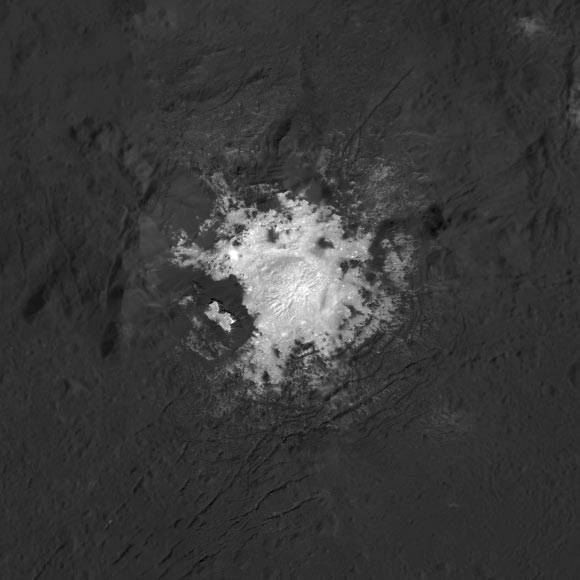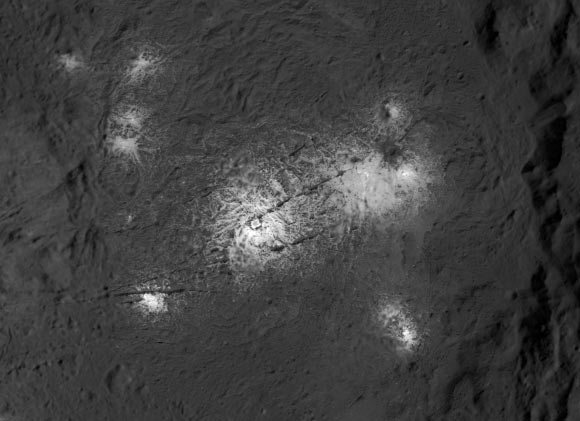New images of Ceres, taken by NASA’s Dawn orbiter, show the bright areas in sharper detail than ever before.

This mosaic of Cerealia Facula is based on images obtained by NASA’s Dawn spacecraft in its second extended mission, from an altitude as low as about 21 miles (34 km). The contrast in resolution obtained by the two phases is visible here, reflected by a few gaps in the high-resolution coverage. This image is superposed to a similar scene acquired in the low-altitude mapping orbit of the mission from an altitude of about 240 miles (385 km). The increased resolution afforded by the low altitude is revealing intimate details about the relationships between bright and dark materials across the facula, which will help resolve the mystery of its origin. Cerealia Facula is located at about 19.7 degrees north latitude and 239.6 degrees east longitude. Image credit: NASA / JPL-Caltech / UCLA / MPS / DLR / IDA / PSI.
Dawn is the only spacecraft to orbit two deep-space destinations.
It studied Vesta, a protoplanet in the main asteroid belt, for 14 months in 2011 and 2012, and arrived at Ceres on March 6, 2015.
At Ceres, the orbiter discovered brilliant, salty deposits decorating the dwarf planet like a smattering of diamonds.
The science behind these bright spots is even more compelling: they are mainly sodium carbonate and ammonium chloride that somehow made their way to the surface in a slushy brine from within or below the crust.
“The new images of Occator crater and the surrounding areas have exceeded expectations, revealing beautiful, alien landscapes,” said Dawn principal investigator Dr. Carol Raymond, of NASA’s Jet Propulsion Laboratory.
“Ceres’ unique surface appears to be shaped by impacts into its volatile-rich crust, resulting in intriguing, complex geology, as we can see in the new high-resolution mosaics of Cerealia Facula and Vinalia Faculae.”

This close-up image of Vinalia Faculae in Occator crater was obtained by the Dawn spacecraft in its second extended mission. This image reveals the intricate pattern between bright and dark material across this flow feature, which scientists will use to infer the history of this area, in particular the role of the fractures in the exposure of bright salts onto the surface. The center of this picture is located at about 20.2 degrees north latitude and 242.0 degrees east longitude. Image credit: NASA / JPL-Caltech / UCLA / MPS / DLR / IDA / PSI.
Dr. Raymond and colleagues are using new high-resolution data from Dawn to test and refine hypotheses about Occator crater’s formation and evolution.
“Observations, modeling and laboratory studies helped us conclude that the bright spots are either formed by impacts interacting with the crust, or that a reservoir of briny melt contributed to their formation,” said Dr. Jennifer Scully, a scientist at NASA’s Jet Propulsion Laboratory.
The new images so far support the hypothesis that exposure of subsurface material in that region is ongoing, and that it is geologically active, feeding from a deep reservoir.







